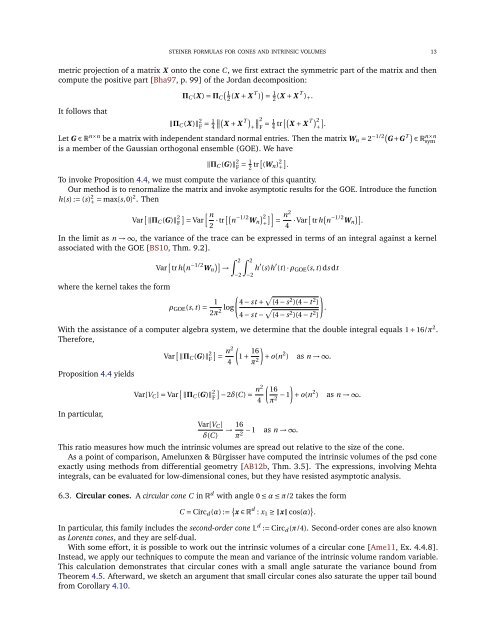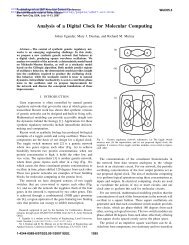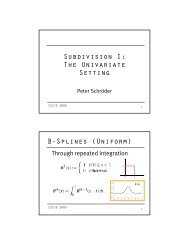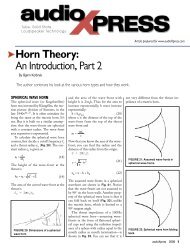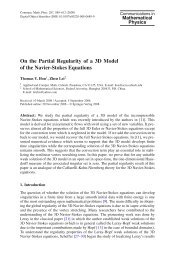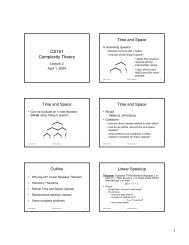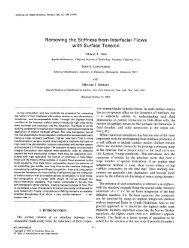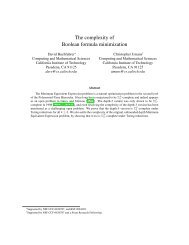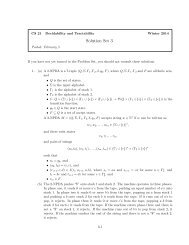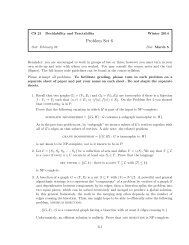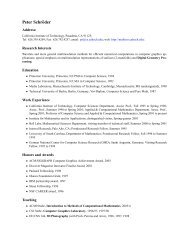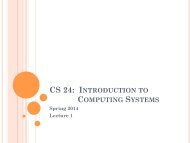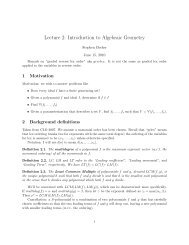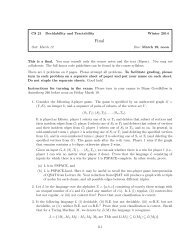From Steiner formulas for cones to concentration of intrinsic volumes
From Steiner formulas for cones to concentration of intrinsic volumes
From Steiner formulas for cones to concentration of intrinsic volumes
Create successful ePaper yourself
Turn your PDF publications into a flip-book with our unique Google optimized e-Paper software.
STEINER FORMULAS FOR CONES AND INTRINSIC VOLUMES 13metric projection <strong>of</strong> a matrix X on<strong>to</strong> the cone C, we first extract the symmetric part <strong>of</strong> the matrix and thencompute the positive part [Bha97, p. 99] <strong>of</strong> the Jordan decomposition:It follows thatΠ C (X ) = Π C( 12 (X + X T ) ) = 1 2 (X + X T ) + .‖Π C (X )‖ 2 F = 1 ∥ (4X + X T ) ∥ 2+ F = 1 4 tr[( X + X T ) 2+].Let G ∈ R n×n be a matrix with independent standard normal entries. Then the matrix W n = 2 −1/2( G +G T ) ∈ R n×nsymis a member <strong>of</strong> the Gaussian orthogonal ensemble (GOE). We have‖Π C (G)‖ 2 F = 1 2 tr[ (W n ) 2 +].To invoke Proposition 4.4, we must compute the variance <strong>of</strong> this quantity.Our method is <strong>to</strong> renormalize the matrix and invoke asymp<strong>to</strong>tic results <strong>for</strong> the GOE. Introduce the functionh(s) := (s) 2 + = max{s,0}2 . ThenVar [ ‖Π C (G)‖ 2 ] [ nF = Var2 · tr[( n −1/2 ) 2 ] ]W n += n24 · Var[ trh ( n −1/2 )]W n .In the limit as n → ∞, the variance <strong>of</strong> the trace can be expressed in terms <strong>of</strong> an integral against a kernelassociated with the GOE [BS10, Thm. 9.2].Var [ trh ( n −1/2 W n)]→∫ 2−2∫ 2−2h ′ (s)h ′ (t) · ρ GOE (s, t)ds dtwhere the kernel takes the <strong>for</strong>m(ρ GOE (s, t) = 12π 2 log 4 − st + √ )(4 − s 2 )(4 − t 2 )4 − st − √ .(4 − s 2 )(4 − t 2 )With the assistance <strong>of</strong> a computer algebra system, we determine that the double integral equals 1 + 16/π 2 .There<strong>for</strong>e,Var [ ‖Π C (G)‖ 2 ] n 2 (F = 1 + 16 )4 π 2 + o(n 2 ) as n → ∞.Proposition 4.4 yieldsIn particular,Var[V C ] = Var [ ‖Π C (G)‖ 2 ] n 2F − 2δ(C) =4Var[V C ]δ(C)→ 16 − 1 as n → ∞.π2 ( 16π 2 − 1 )+ o(n 2 ) as n → ∞.This ratio measures how much the <strong>intrinsic</strong> <strong>volumes</strong> are spread out relative <strong>to</strong> the size <strong>of</strong> the cone.As a point <strong>of</strong> comparison, Amelunxen & Bürgisser have computed the <strong>intrinsic</strong> <strong>volumes</strong> <strong>of</strong> the psd coneexactly using methods from differential geometry [AB12b, Thm. 3.5]. The expressions, involving Mehtaintegrals, can be evaluated <strong>for</strong> low-dimensional <strong>cones</strong>, but they have resisted asymp<strong>to</strong>tic analysis.6.3. Circular <strong>cones</strong>. A circular cone C in R d with angle 0 ≤ α ≤ π/2 takes the <strong>for</strong>mC = Circ d (α) := { x ∈ R d : x 1 ≥ ‖x‖cos(α) } .In particular, this family includes the second-order cone L d := Circ d (π/4). Second-order <strong>cones</strong> are also knownas Lorentz <strong>cones</strong>, and they are self-dual.With some ef<strong>for</strong>t, it is possible <strong>to</strong> work out the <strong>intrinsic</strong> <strong>volumes</strong> <strong>of</strong> a circular cone [Ame11, Ex. 4.4.8].Instead, we apply our techniques <strong>to</strong> compute the mean and variance <strong>of</strong> the <strong>intrinsic</strong> volume random variable.This calculation demonstrates that circular <strong>cones</strong> with a small angle saturate the variance bound fromTheorem 4.5. Afterward, we sketch an argument that small circular <strong>cones</strong> also saturate the upper tail boundfrom Corollary 4.10.


